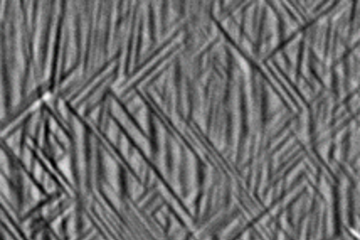All genres
561.
Talk
Advanced Atom Probe Tomography. 25th Annual Meeting of the German Crystallographic Society, Karlsruhe, Germany (2017)
562.
Talk
Ab Initio Guided Design of High Strength Steels: Where Do We Stand? TMS, San Diego, CA, USA (2017)
563.
Talk
Parameter-free Finite-temperature Computations of Stacking Fault Energies for Magnetic Materials. TMS Annual Meeting 2017, San Diego, CA, USA (2017)
564.
Talk
Atomic Scale Characterization of Complex Materials. Physikalisches Kolloquium, Fakultät für Mathematik und Physik, Universität Freiburg, Freiburg, Ger,amy (2017)
565.
Talk
Ab-initio investigation of the interaction of hydrogen with carbides in advanced high-strength steels. TMS 2017, San Diego, CA, USA (2017)
566.
Talk
Deformation Induced Martensite: A Thermodynamic Study. TMS 2017, San Diego, CA, USA (2017)
567.
Talk
Parameter-free Computational Design of Magnetic Materials – Recent Advances in Ab Initio Techniques of Coupled Lattice and Spin Fluctuations. MRS Fall Meeting 2016, Boston, MA, USA (2016)
568.
Talk
Solvent-controlled single atom dissolution, surface alloying and Wulff shapes of nanoclusters; Electrocatalysis at electrocodes in the dry. Workshop: Research Area III, ZEMOS, Bochum, Germany (2016)
569.
Talk
Point Defects at Finite Temperatures. BUNSEN COLLOQUIUM - Defects and Diffusion in Solids, RWTH Aachen, Aachen, Germany (2016)
570.
Talk
Ab-Initio Guided Design of Twinning Induced Plasticity and Weight Reduced Austenitic Steels. MRS Fall Meeting, Boston, MA, USA (2016)
571.
Talk
Segregation Engineering - Solute Decoration, Complexions and Transformations for Self-Organized Metallurgical Bulk Nanostructures. MRS Fall Meeting, Boston, MA, USA (2016)
572.
Talk
Collective variable description of crystal anharmonicity. IPAM Workshop II: Collective Variables in Classical Mechanics, Los Angeles, CA, USA (2016)
573.
Talk
Ordering Phenomena in InGaN Alloys-An Ab-Initio Thermodynamics Study. International Workshop on Nitride Semiconductors (IWN2016), Orlando, FL, USA (2016)
574.
Talk
Modelling structural materials in extreme environments by ab initio guided multiscale simulations. International Workshop “Theory and Modelling of Materials in Extreme Environment", Abingdon, UK (2016)
575.
Talk
Ab initio thermodynamic description of advanced structural materials: Status and challenges. Workshop “Ab-initio Based Modeling of Advanced Materials”, Yekaterinburg, Russia (2016)
576.
Talk
Stahl: Wie ein alter Werkstoff sich immer wieder neu erfindet und damit Wissenschaft und Wirtschaft beflügelt. 129. Versammlung der Gesellschaft der deutschen Naturforscher und Ärzte, Greifswald, Germany (2016)
577.
Talk
Intermartensitic Phase Boundaries in Ni–Mn–Ga Alloys: A Viewpoint from Ab initio Thermodynamics. 5th International Conference on Ferromagnetic Shape Memory Alloys, Sendai, Japan (2016)
578.
Talk
Thermodynamic properties of the quaternary Q phase in Al–Cu–Mg–Si: a combined ab-initio, phonon and compound energy formalism approach. Materials Science and Engineering 2016 (MSE), Darmstadt, Germany (2016)
579.
Talk
Thermodynamic properties of the quaternary Q phase in Al–Cu–Mg–Si: a combined ab-initio, phonon and compound energy formalism approach. International Conference on Advanced Materials Modelling (ICAMM), Rennes, France (2016)
580.
Talk
Ab initio description of defects in materials under extreme conditions. 2016 Joint ICTP-CAS-IAEA School and Workshop on Plasma-Material Interaction in Fusion Devices, Hefei, China (2016)











